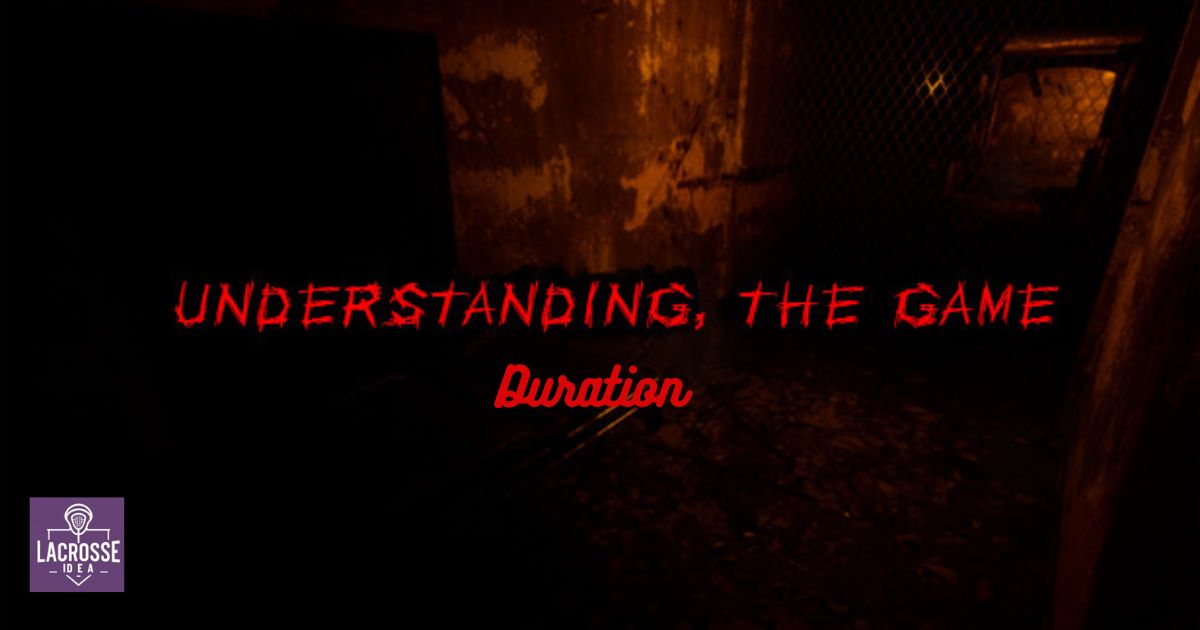Step into the thrilling world of lacrosse, where time seemingly dances on the field, weaving its way through the intense battles and strategic maneuvers. Ever wondered how long a lacrosse game lasts? In this article, we will unravel the mysteries of game duration, shedding light on the factors that influence it. Whether you’re a player, a coach, or a passionate fan, join us as we explore the intricacies of this exhilarating sport and gain a deeper understanding of the time it takes to achieve victory.
Key Takeaways
- A typical lacrosse game consists of four quarters, each lasting 15 minutes, for a total of 60 minutes.
- On average, a lacrosse match lasts for approximately 90 minutes, including game stoppages and halftime.
- Penalties, injuries, and timeouts can all affect the duration of a lacrosse game.
- Overtime is played in sudden death format and adds excitement to the game.
Understanding The Game Duration
The game duration in lacrosse is determined by the possession and actions of the players on the field. A typical lacrosse game consists of four quarters, each lasting 15 minutes, for a total of 60 minutes. However, due to various factors, the actual length of a game can vary. Some games may take longer if there are many stoppages, such as penalties or injuries, which interrupt the flow of play. On the other hand, teams can employ strategies to speed up gameplay and shorten the duration of a game.
For example, teams can focus on quick and efficient ball movement, avoiding unnecessary delays and maximizing scoring opportunities. Additionally, coaches can implement high-pressure defensive tactics to force turnovers and regain possession quickly. By utilizing these strategies, teams can minimize game length and maintain a fast-paced, action-packed game for spectators.
Average Length Of A Lacrosse Match
On average, a lacrosse match lasts for approximately 90 minutes, including game stoppages and halftime. Understanding the game rules and employing strategies to speed up gameplay can further enhance the overall duration of the match. Lacrosse is known for its fast-paced nature, and players and coaches often employ various tactics to maintain the flow of the game.
One effective strategy is the implementation of quick restarts after goals or fouls, allowing for less downtime and more continuous action. Efficient substitutions and smooth transitions between offense and defense can help keep the game moving swiftly. By promoting a thorough understanding of the rules and utilizing strategies to expedite gameplay, lacrosse matches can maintain a dynamic and engaging environment for players and fans alike.
Factors Affecting Game Time
Factors such as penalties, injuries, and timeouts can significantly impact the duration of a lacrosse game. Understanding game dynamics and implementing strategies for managing game time can help teams stay on track and maintain control over the length of the match. Here are five key factors that can affect the duration of a lacrosse game:
- Penalties: The more penalties called, the more time is added to the game clock.
- Injuries: Serious injuries may require extended stoppages in play, prolonging the game.
- Timeouts: Each team is allowed a certain number of timeouts, which can stop the clock and extend the game.
- Defensive strategies: Teams that employ slow-paced, defensive tactics can slow down the game and reduce scoring opportunities.
- Offensive strategies: Conversely, teams that opt for fast-paced, aggressive offensive strategies can increase the pace of the game and result in more goals.
Regulation Time Vs Overtime
When comparing regulation time to overtime in a lacrosse game, it is important to understand the implications on game duration and potential outcomes. Overtime rules come into play when the game is tied at the end of regulation time. In lacrosse, overtime is played in sudden death format, where the first team to score wins the game. Each team is given a specific number of possessions, usually two or three, to determine the winner.
If the game remains tied after the allotted possessions, additional overtime periods may be played until a winner is determined. Overtime adds excitement to the game and ensures that there is always a clear winner. Now that we have discussed the regulation time and overtime rules, let’s move on to the next aspect of lacrosse games: timeouts and halftime break.
Timeouts And Halftime Break
After regulation time and overtime, lacrosse games also include timeouts and a halftime break. These brief respites during the game play an important role in time management and allow teams to regroup and strategize. Here are some key aspects to consider regarding timeouts and halftime breaks:
- Timeout duration: Each team is allowed two timeouts per game, each lasting one minute.
- Strategic discussions: During timeouts, coaches can provide guidance, make adjustments, or motivate their players.
- Time management: Teams must carefully choose when to use their timeouts, as they can impact the flow of the game.
- Halftime break: This break typically lasts for ten minutes and provides players with an opportunity to rest and recover.
- Impact of weather: In cases of extreme weather conditions, additional timeouts may be granted to ensure player safety.
Understanding the importance of timeouts and halftime breaks in lacrosse is crucial for both players and spectators. Now, let’s explore the significance of game pace.
Importance Of Game Pace
Game pace in lacrosse is a critical factor that directly influences the dynamics and outcomes of the match. Analyzing the game pace is essential for teams to develop effective strategies for time management. A fast-paced game requires players to make quick decisions and execute rapid plays, putting pressure on the opposing team’s defense. On the other hand, a slow-paced game allows teams to control possession and carefully plan their offensive moves.
Understanding the game pace allows coaches to adjust their tactics accordingly, whether it means encouraging a high-intensity style of play or adopting a more patient approach. By analyzing the game pace, teams can gain a competitive advantage and increase their chances of success. Effective strategies for time management can help teams maintain control of the game and capitalize on scoring opportunities.
Impact Of Penalties On Game Length
Penalties in lacrosse have a significant impact on the duration of the game. When players commit fouls or violations, the game clock stops, and the penalized player is removed from play for a designated amount of time. This not only disrupts the flow of the game but also extends its length. The impact of penalties on game length can be seen through various factors:
- Frequency of Penalties: The more penalties that occur in a game, the more time is added to the overall duration.
- Duration of Penalties: Depending on the severity of the penalty, players may be sidelined for a few seconds or several minutes, further delaying the game.
- Penalty Kill Strategies: Teams must strategize and adjust their gameplay when playing short-handed, which can slow down the pace of the game.
- Referee Discussions: Referees often need to confer and make decisions regarding penalties, leading to additional stoppages in play.
- Player Fatigue: Extended penalty kill situations can tire players, leading to slower gameplay and an overall longer game.
Managing game time becomes crucial to ensure that penalties do not excessively prolong matches. Referees and coaches play a vital role in enforcing the rules and maintaining game flow. By minimizing penalties and efficiently managing penalty situations, the duration of lacrosse games can be kept within reasonable limits.
Length Of Youth Lacrosse Games
Youth lacrosse games typically have shorter durations compared to adult games, but the length can vary depending on several factors. Understanding the game format and employing strategies for managing game time can help ensure a smooth and efficient experience for players and spectators alike.
Here is a breakdown of the typical lengths for different levels of youth lacrosse games:
| Level | Game Duration |
|---|---|
| U9 | 20 minutes |
| U11 | 25 minutes |
| U13 and U15 | 30 minutes |
It’s important to note that these durations may vary depending on league rules and tournament guidelines. Additionally, factors such as weather conditions, timeouts, and the pace of play can also impact the overall length of a youth lacrosse game.
To make the most of the allotted time, coaches and officials can employ strategies such as managing substitutions efficiently, utilizing timeouts strategically, and encouraging players to maintain a quick pace of play. By doing so, they can ensure that youth lacrosse games are engaging, competitive, and enjoyable for all involved.
Duration Of College Lacrosse Matches
College lacrosse matches have longer durations compared to youth games, with the length of the game varying depending on several factors. Here are some key factors that can impact the duration of a college lacrosse match:
- The impact of weather on game time: Inclement weather conditions such as heavy rain or lightning can lead to game delays or even cancellations. This can significantly prolong the duration of a match.
- Strategies for speeding up a lacrosse match: Coaches and officials may implement various strategies to ensure a timely game, such as enforcing shot clocks, implementing running time, or reducing the number of timeouts allowed.
- Level of competition: Higher-level college lacrosse matches often involve more intense gameplay and strategic decisions, which can naturally extend the duration of the game.
- Overtime periods: If a match ends in a tie, additional overtime periods may be played, further extending the duration of the game.
- Television broadcast: College lacrosse matches that are televised may have additional breaks for commercials, contributing to a longer game duration.
As we move on to discussing the duration of professional lacrosse games, it is important to note the differences and similarities with college matches.
Professional Lacrosse Game Duration
In professional lacrosse, the duration of a game can vary depending on several factors. Unlike college lacrosse matches, which have a fixed duration of 60 minutes, professional lacrosse games are typically divided into four quarters of 15 minutes each. However, additional time can be added for stoppages, such as penalties and injuries. This means that the actual playing time can extend beyond the allotted 60 minutes.
Understanding the game rules and strategies for winning is crucial in professional lacrosse. Teams must employ effective offensive and defensive tactics, utilize their skills and athleticism, and make quick decisions to outscore their opponents. Coaches play a significant role in devising game plans and making in-game adjustments to secure victory. Professional lacrosse games offer an exciting and dynamic spectacle for fans and players alike.
Comparing Lacrosse To Other Sports
When comparing lacrosse to other sports, it is important to consider the duration of the game. Lacrosse and soccer are both popular sports that require agility, teamwork, and strategic thinking. However, there are notable differences in their game lengths. While a lacrosse game typically lasts around 60 minutes, a soccer match can go on for 90 minutes or more. It is worth examining game length in different lacrosse leagues.
In Major League Lacrosse (MLL), the regulation game consists of four 15-minute quarters, while in the National Lacrosse League (NLL), the game is divided into four 15-minute quarters as well. On the other hand, college lacrosse games have four 15-minute quarters for men and two 30-minute halves for women. Understanding these variations can help fans and players appreciate the unique aspects of lacrosse compared to other sports.
Tips For Managing Game Time
To effectively manage game time in lacrosse, it is essential for players and coaches to prioritize efficient strategies and tactical decision-making. Managing game flow requires a combination of clock management, effective play-calling, and quick decision-making on the field. One strategy for time management is utilizing a fast-paced offense that keeps the opposing team on their toes and prevents them from stalling. This can be achieved by focusing on quick passes, constant movement, and aggressive offensive plays.
Coaches can implement a structured substitution system that ensures players are rotated efficiently and maximizes their energy levels throughout the game. Moreover, effective communication between players and coaches is crucial in managing game time, as it allows for quick adjustments and strategic decisions. By employing these strategies, teams can optimize their game time and increase their chances of success on the lacrosse field.
Frequently Asked Questions
Are There Any Rules on How Long a Team Can Hold Possession of the Ball During a Lacrosse Game?
Rules on ball possession in lacrosse dictate that there are no specific time limits on how long a team can hold the ball. However, teams are encouraged to maintain an active and continuous play, promoting a dynamic and engaging game for both players and spectators.
How Long Is the Halftime Break in a Lacrosse Match?
The halftime break in a lacrosse match typically lasts for a designated period of time. This break allows players to rest, recover, and strategize, ultimately impacting their performance in the second half of the game.
Does the Length of a Lacrosse Game Vary Depending on the Level of Play?
The length of a lacrosse game can vary depending on the level of play, with higher levels typically having longer durations. Factors such as game pace, skill level, and number of stoppages contribute to the overall length of lacrosse matches.
Can a Lacrosse Game End in a Tie, or Are There Always Overtime Periods?
A lacrosse game can end in a tie, but overtime periods are often used to determine a winner. The impact of weather on game duration and the influence of game officials on overtime periods can vary.
Are There Any Specific Strategies or Techniques That Teams Can Use to Speed up or Slow Down the Pace of a Lacrosse Game?
Teams can employ various strategies to increase scoring in a lacrosse game, such as quick ball movement and aggressive offensive play. Conversely, techniques for controlling the pace include patient ball possession and deliberate defensive tactics.
Conclusion
In conclusion, the duration of a lacrosse game can vary depending on various factors such as the level of play, regulations, and timeouts. On average, a lacrosse match lasts around 1.5 to 2 hours. However, factors such as overtime and halftime breaks can extend the game time. For example, in a college lacrosse match, the duration may be longer due to the inclusion of four 15-minute quarters and longer halftime breaks.









